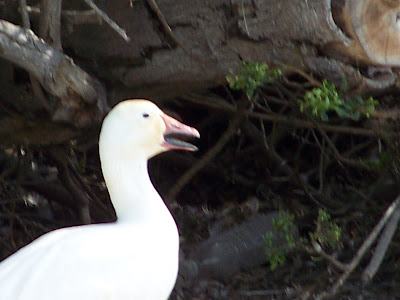Snow Geese are rare, but they are regularly seen in Orange County because California and thus Orange County are on the migration route to their Canadian breeding grounds.
 With the hungry, gluttonous ducks and coots feeding on handouts. Kind of makes me sad.
With the hungry, gluttonous ducks and coots feeding on handouts. Kind of makes me sad.
Snow Goose swimming in a lake in a small neighborhood park.
Notice the pink legs.
Notice the tint on the head.
What're you looking at? Notice the yellowish coloring tinting the face.

Notice the very prominent black grin patch.
Differentiating Snow Geese from domestic, white geese

Larger Domestic Goose--Large, with Orange legs and bill. Notice the large looking belly. The Snow Goose would be smaller and have a smaller belly. All white wings.

Orange eye ring, smaller light-colored grin patch. All white. The Snow Goose has no orange eye ring, dark eyes, and a pink bill with a black grin patch.
 Unlike the dark-eyed Snow Goose, the domestic goose has blue eyes.
Unlike the dark-eyed Snow Goose, the domestic goose has blue eyes.Snow Geese and Ross's Geese
Here, a Ross's Goose hangs out in a San Fernando Valley park with other geese. Notice he has the same coloring as the Snow Goose, but the Ross's Goose is much smaller. The Ross's Goose has no tinting on the head or neck. Whiter overall head and neck than the Snow Goose. The bill is much smaller proportionally than the Snow Goose, and can show a bit of green coloring at the base. The Ross's Goose may have a much smaller and less obvious grin patch.
The Snow Goose has a larger bill compared to the Ross's Goose, and a large, dark grin patch. Unlike the domestic goose, the Snow Goose has dark eyes vs. the domestic's blue eyes. The Snow Goose black wing tips unlike the white wings of the domestic goose. The Snow Goose has a pink bill and legs unlike the orange bill and legs of the domestic goose.
OC Birder Girl Links
Wild Ducks of Orange County
Odd Ducks
Bird Walks and Nature Programs in and Near Orange County
Orange County Bird Check Lists
Herons, Egrets, and Bitterns of Orange County
Links
All About Birds: Snow Goose
Detailed page about the Snow Goose. Although it is multiplying, it is still a rare bird in Orange County. Read all about the Snow Goose.
All About Birds: Ross's Goose
Detailed page about the Ross's Goose. Rare in Orange County.
Confusing Domestic Geese (and hybrids)
From Cornell. Some confusing geese.
Snow Geese Fuel up for Migration
Read more about Snow Geese.































